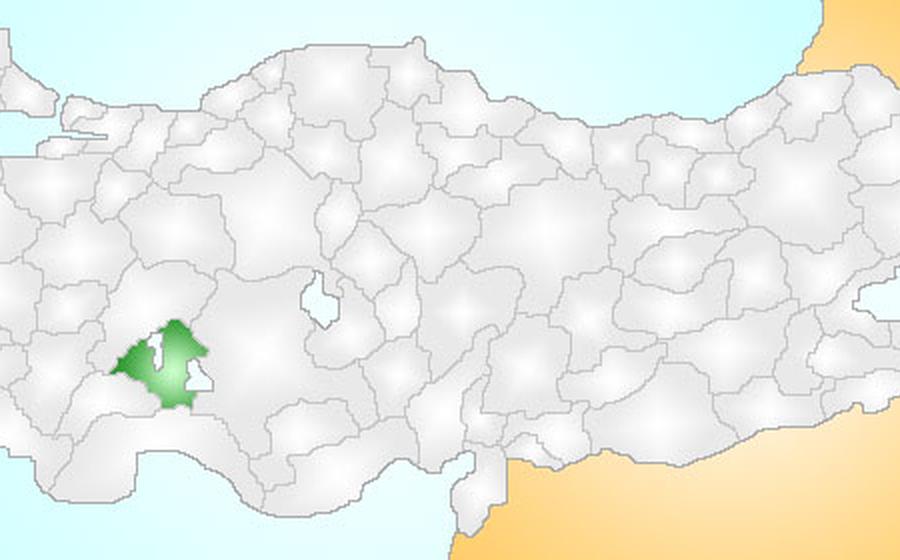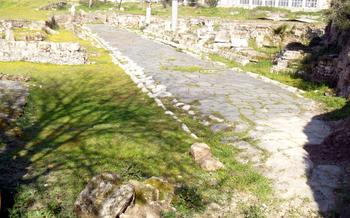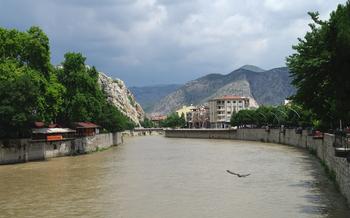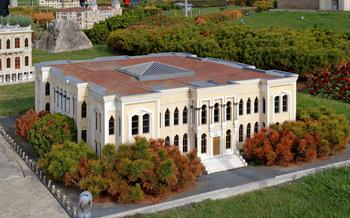
The Stone Bridge of Eğirdir
- History of the Stone Bridge of Eğirdir: A Timeless Landmark
- Location and Accessibility
- Architectural Features
- Dimensions and Statistics
- Surrounding Landscape and Views
- Historical Significance
- Cultural Importance
- Restoration and Preservation
- Tourism and Visitor Experience
- Local Crafts and Handicrafts
- Gastronomic Delights
- Outdoor Activities and Recreation
- Festivals and Events
- Accommodation and Lodging
History of the Stone Bridge of Eğirdir: A Timeless Landmark
The Stone Bridge of Eğirdir, an architectural marvel that has stood the test of time, was constructed in the 13th century during the reign of the Seljuk Sultanate. This period marked a time of significant advancements in engineering and infrastructure development, and the bridge served as a testament to the region's prosperity and strategic importance. Built with meticulous precision and a keen eye for detail, the bridge showcased the architectural prowess of the era, combining functionality with aesthetic beauty.
The bridge's design reflects a blend of Seljuk and Byzantine influences, showcasing pointed arches and intricate stone carvings that speak volumes about the cultural heritage of the region. Its strategic location, spanning the Eğirdir Lake, facilitated trade and transportation between neighboring settlements, making it a vital link in the region's economic and social fabric. Over the centuries, the bridge has witnessed countless historical events, serving as a silent observer of the region's rich past, and now stands as a symbol of resilience and enduring legacy.
Location and Accessibility
The Stone Bridge of Eğirdir is a magnificent sight to behold, situated in the heart of Isparta, a city in southwestern Turkey. It gracefully spans the pristine waters of Lake Eğirdir, a natural wonder renowned for its crystal-clear waters and breathtaking scenery. The bridge serves as a vital link between the city center and the picturesque villages nestled along the lake's shores.
To reach this architectural marvel, visitors can embark on a scenic journey from nearby cities such as Antalya, approximately 140 kilometers away, or Denizli, located 180 kilometers distant. Once in Isparta, the bridge is easily accessible by car, with well-maintained roads leading directly to the site. Alternatively, public transportation options, including buses and taxis, are readily available, offering a convenient and affordable means of reaching the bridge.
For those with limited mobility, the bridge is designed with accessibility in mind. Ramps and designated pathways ensure that visitors of all abilities can fully experience the grandeur of this historic structure. Whether arriving by car or using public transport, visitors will find ample parking spaces available near the bridge, making their visit both convenient and hassle-free.
Architectural Features
The Stone Bridge of Eğirdir stands out for its unique design elements, showcasing the ingenuity and skill of its ancient builders. The bridge features a series of pointed arches, a distinctive characteristic that sets it apart from other stone bridges in the region. These arches, varying in size and shape, create a rhythmic pattern that adds to the bridge's visual appeal.
Constructed using locally sourced materials, the bridge primarily incorporates limestone and basalt stones. The choice of these materials not only ensured durability but also harmonized with the surrounding natural environment. The stones were carefully cut and shaped to fit precisely, without the use of mortar or cement, demonstrating the advanced construction techniques of the time.
The bridge's structural components include massive piers and abutments that support the weight of the arches and the traffic that crosses the bridge. These piers, positioned at strategic intervals, effectively distribute the load and ensure the stability of the structure. The bridge's engineering prowess is further evident in the use of voussoirs, wedge-shaped stones that form the arches. These voussoirs are skillfully arranged to create a self-supporting structure, without the need for additional reinforcement.
Dimensions and Statistics
The Stone Bridge of Eğirdir is a truly impressive structure, both in terms of its size and its engineering prowess. Spanning a total length of 122 meters, the bridge consists of 12 arches, each measuring an impressive 6 meters in width. The height of the bridge, from the water level to the top of the arches, is approximately 10 meters. This combination of length, width, and height creates a sense of grandeur and solidity that is truly awe-inspiring.
In terms of weight, the bridge is estimated to weigh an incredible 3,000 tons. This immense weight is a testament to the engineering skill and craftsmanship of the bridge's builders, who managed to create such a massive structure without the use of modern construction materials or techniques. It is also worth noting that the bridge was constructed over a period of 10 years, which speaks to the dedication and determination of the builders.
For those interested in comparing the Stone Bridge of Eğirdir to other notable stone bridges, here are a few examples:
- Puente Viejo (Ronda, Spain): Length: 70 meters, Height: 35 meters, Number of Arches: 7
- Pont du Gard (Vers-Pont-du-Gard, France): Length: 275 meters, Height: 49 meters, Number of Arches: 36
- Karamagara Bridge (Karaman, Turkey): Length: 140 meters, Height: 12 meters, Number of Arches: 10
As you can see, the Stone Bridge of Eğirdir holds its own in terms of size and grandeur when compared to other famous stone bridges around the world.
Surrounding Landscape and Views
The Stone Bridge of Eğirdir is nestled amidst the breathtaking natural beauty of Eğirdir Lake and the majestic Taurus Mountains. The bridge offers panoramic views of the shimmering lake, surrounded by lush forests and snow-capped peaks. The surrounding landscape is a photographer's paradise, with endless opportunities to capture stunning images of the bridge and its picturesque setting.
Visitors can take a leisurely stroll along the bridge and soak in the tranquility of the surroundings. The bridge provides a unique vantage point to witness the changing colors of the lake and the surrounding mountains throughout the day. The clear waters of the lake reflect the vibrant hues of the sky, creating a mesmerizing spectacle at sunrise and sunset.
The bridge's location also makes it a popular spot for nature enthusiasts. The surrounding area is rich in biodiversity, with a variety of flora and fauna. Visitors can spot migratory birds, such as pelicans and cormorants, soaring over the lake. The mountains are home to diverse wildlife, including ibex, wolves, and bears.
Historical Significance
The Stone Bridge of Eğirdir stands as a testament to the rich history and cultural heritage of the region. In ancient times, it served as a vital link in the trade routes that connected the Anatolian hinterland with the Mediterranean coast. Merchants and travelers from far and wide crossed the bridge, carrying goods and exchanging ideas. The bridge also played a strategic role in military campaigns, as armies marched through the Eğirdir region to conquer new territories or defend existing ones.
Over the centuries, the bridge witnessed the rise and fall of civilizations, from the Hittites to the Romans, the Byzantines to the Seljuks, and finally the Ottomans. Each empire left its mark on the bridge, contributing to its unique architectural style and historical significance. In recognition of its outstanding universal value, the Stone Bridge of Eğirdir was inscribed as a UNESCO World Heritage Site in 2016, joining the ranks of the world's most treasured cultural landmarks.
Cultural Importance
The Stone Bridge of Eğirdir holds immense cultural significance, deeply interwoven with the local identity and traditions of the region. Over the centuries, it has become a symbol of unity, resilience, and historical continuity. Local legends and folklore surround the bridge, passed down through generations, adding to its mystique and allure. These stories often involve tales of brave warriors, star-crossed lovers, and mystical occurrences that have shaped the cultural fabric of the region.
Traditional festivals and celebrations are held near the bridge, honoring its significance and paying homage to its enduring presence. These events showcase traditional Turkish music, dance, and customs, attracting locals and tourists alike. The bridge serves as a backdrop for these vibrant displays of cultural heritage, creating a sense of awe and wonder among those in attendance.
Restoration and Preservation
The passage of time and exposure to the elements have taken their toll on the Stone Bridge of Eğirdir, necessitating ongoing efforts to maintain and restore its original structure. Local authorities and heritage organizations have collaborated to address this challenge, employing techniques that minimize disruption to the bridge's historical integrity.
To safeguard the bridge from weathering and damage, a combination of traditional and modern methods is utilized. Skilled artisans employ time-honored techniques to repair damaged stones and mortar joints, while engineers implement innovative solutions to reinforce the bridge's foundations and structural components.
Regular inspections and monitoring are conducted to identify areas requiring attention, and interventions are carefully planned to ensure minimal impact on the bridge's overall appearance and historical significance. The restoration process involves meticulous documentation and adherence to strict conservation guidelines, ensuring that the bridge's authenticity and cultural value are preserved for future generations.
By striking a balance between preservation and modernization, the Stone Bridge of Eğirdir continues to stand as a testament to the enduring spirit of Turkish craftsmanship and the dedication of those committed to protecting its legacy.
Tourism and Visitor Experience
The Stone Bridge of Eğirdir is a popular tourist attraction, drawing visitors from around the world to marvel at its architectural beauty and historical significance. Visitors can explore the bridge on foot, admiring its intricate details and taking in the breathtaking views of Eğirdir Lake and the surrounding mountains. Guided tours are available for those who want to learn more about the bridge's history and cultural importance. Informational plaques and signs provide additional insights into its construction and significance.
For a truly immersive experience, visitors can take a boat tour on Eğirdir Lake, which offers stunning views of the bridge from a different perspective. The lake is also a popular spot for swimming, fishing, and other water sports. Visitors can also enjoy picnics and camping in the surrounding area, making the bridge a perfect destination for a day trip or a longer stay.
Local Crafts and Handicrafts
The region surrounding the Stone Bridge of Eğirdir is home to a vibrant community of artisans and craftsmen who create traditional handicrafts using techniques passed down through generations. Visitors can explore workshops and demonstrations to witness the skill and dedication of these artisans as they create exquisite pieces of art. From intricate carpets and textiles to hand-painted ceramics and jewelry, there is a wide range of unique souvenirs and gifts to be found. By purchasing these locally made crafts, travelers not only support the local economy but also contribute to the preservation of Turkey's rich cultural heritage.
Gastronomic Delights
When visiting the Stone Bridge of Eğirdir, don't miss the opportunity to indulge in the region's culinary delights. The area boasts a rich agricultural heritage, and the local cuisine reflects the fresh, seasonal produce grown in the fertile lands surrounding the lake.
Traditional Turkish dishes are widely available, and you'll find restaurants and cafes offering a variety of options to satisfy your taste buds. Sample the delicious köfte (meatballs), succulent kebabs grilled to perfection, or the flavorful pide (Turkish flatbread) topped with various fillings.
For a unique experience, head to the local markets or street food stalls to savor the authentic flavors of the region. Try the gözleme, a traditional Turkish flatbread filled with cheese, potatoes, or minced meat, or indulge in the sweetness of lokma, deep-fried dough balls soaked in syrup.
Whether you're looking for a hearty meal or a sweet treat, the Eğirdir region offers a culinary journey that will tantalize your taste buds and leave you wanting more. Embrace the local cuisine and discover the hidden gems of Turkish gastronomy.
Outdoor Activities and Recreation
The picturesque surroundings of the Stone Bridge of Eğirdir offer a range of outdoor activities and recreational pursuits for nature enthusiasts. For those who enjoy hiking and trekking, the nearby mountains provide challenging trails with breathtaking views. The pristine waters of Eğirdir Lake invite visitors to indulge in water sports such as boating, kayaking, and swimming. Anglers can cast their lines in search of trout and other freshwater fish in the lake's clear waters.
For a leisurely experience, visitors can pack a picnic and find a spot near the bridge to relax and enjoy the tranquil atmosphere. Several designated picnic areas offer tables, benches, and grills for a comfortable outdoor dining experience. Camping enthusiasts can pitch their tents at designated campsites, immersing themselves in the natural beauty of the area under the starry night sky.
Festivals and Events
Eğirdir comes alive with vibrant festivals and cultural events throughout the year, providing a unique opportunity to immerse oneself in Turkish traditions and heritage. The most notable event is the Eğirdir Mesir Macunu Festival, held annually in May. This colorful festival celebrates the town's renowned medicinal paste, Mesir Macunu, which is believed to have healing properties. Visitors can witness traditional parades, folk dances, and music performances, as well as sample the famous paste and other local delicacies.
Other notable events include the Eğirdir Göl Festivali (Lake Festival) in July, featuring water sports competitions, boat races, and lakeside concerts. The Eğirdir Kültür ve Sanat Festivali (Culture and Arts Festival) in August showcases local artisans, musicians, and dancers, offering a glimpse into the rich cultural heritage of the region.
Participating in these festivals is a fantastic way to connect with the local community, experience the vibrant Turkish culture firsthand, and create lasting memories of your visit to Eğirdir. Be sure to check the festival calendar in advance to plan your trip accordingly and make the most of these special events.
Accommodation and Lodging
When it comes to accommodation in Eğirdir, you'll find a range of options to suit different budgets and preferences. There are modern hotels that offer comfortable rooms with all the amenities you'd expect, as well as charming guesthouses that provide a more intimate and local experience. For those seeking a truly unique stay, traditional Turkish guesthouses, known as pansiyons, offer a chance to immerse yourself in the local culture and enjoy warm Turkish hospitality.
No matter which type of accommodation you choose, be sure to book in advance, especially if you're visiting during the peak tourist season. This will ensure that you have a place to stay and can avoid any last-minute surprises. To find the best deals, consider checking online booking platforms or contacting the local tourism office for recommendations.









